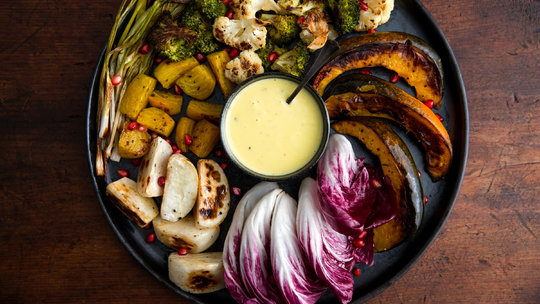
Aioli With Roasted Vegetables
Melissa Clark makes aioli with lemon juice and serves it with roasted broccoli, cauliflower, beets and other seasonal vegetables.
Video by Jenny Woodward on Publish Date October 24, 2014. Photo by Andrew Scrivani for The New York Times.

Provençal cuisine is famously and wonderfully garlic-scented. So I thought I was prepared for the heady allium wallop in my aioli platter one afternoon in Vence.
The pale mound of aioli was scooped into an earthenware bowl, surrounded by boiled potatoes, beets, artichokes and other vegetables. I’d had plenty of aioli in the States and, being a garlic lover, thought nothing of heaping a large spoonful on a piece of bread to get started. The first taste was silky and mild. But as I chewed, the garlic flavor mounted, becoming stronger and more intense until its bite was sharper than mine and my eyes started to water as if I’d eaten a chile. Spicy and intensely pungent, it was like biting into a raw garlic clove — albeit a soft and creamy one.
And I couldn’t get enough.
When I got home, I started making aioli all the time, using it in place of its more refined, emulsified cousin, mayonnaise. I learned that aioli is fantastic in egg salad and divine in potato salad, and that nothing beats it in a B.L.T. It can even turn a platter of humble roasted vegetables into an opulent side dish for your next dinner party if you take care to provide mints along with dessert.
If you’ve made mayonnaise, aioli isn’t a leap. I used to swear by a mortar and pestle, adding the oil drip by drip. It’s slow going but gives you control. (A whisk and bowl also works well.) I never once broke an aioli made by hand.
But being in more of a hurry lately, I’ve moved on to the blender. The key here is to use a low setting like “mix.” (Beware the ferocious, ice-breaking “smoothie” setting.) Then I add the oil in a thin, steady stream. The aioli should all come together in under two minutes. If you run the machine longer, or set it on high, you risk overheating the ingredients, which can cause the emulsion to break. You want all your ingredients to start out, and remain, at room temperature for the strongest emulsion.
If you haven’t made aioli before, start with one garlic clove and add more if you can take it. For a mellower flavor, consider sautéing the garlic first. They wouldn’t do it that way in Provence. But your kitchen can be just as garlic-scented as you like.